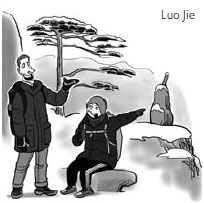With my sister visiting China for the first time, I wanted to show her something ancient - something that would allow me to fulfill my self-proclaimed role as Family China Expert by explaining and interpreting its cultural significance with grace and flair, all the while surrounded by natural splendor unspoiled by modern life even after thousands of years.

After helping her up the icy peaks of Huangshan, Anhui province, I was ready to recite my armchair thesis about the famous "Welcoming Guest Pine Tree". I wasn't, however, ready for "Mobilephone Stone".
I embraced this most meritorious pine tree that represents traditional Chinese culture and graces teacups and hotel lobbies across the land. Yet, no sooner had I launched into my pontification than I noticed my sister wasn't listening. So I canned my over-eager pedantry and read the sign by the potato-shaped boulder that she was absorbed in. It read: "Shouji Shi, Mobilephone Stone." She asks me.
The sign detailed how nature had so graciously endowed the stone with cell phone body and antennae, thanks to the rock wearing down at different rates. After we finished reading it, my sister brought my ego back down to size: "So what do cell phones represent in traditional Chinese culture and exactly which poets have verses about the symbolism of antennas and ringtones?"
I wasn't prepared to explain what had inspired the crowning of Mobilephone Stone. I was prepared to explain how "Welcoming Guest Pine Tree" had earned its stardom for embodying the Chinese value of welcoming guests as it appears to bend over to provide shelter for weary hikers. Travelers from all over China still make grueling pilgrimages just to fight crowds for a snapshot with the popular pine, even though the original tree has long since withered and died. To me, that makes the pilgrimage really not much more than a quest for a second-string star, like Lassies 2 through 8.

Original or not, the message of the tree is clear: In China, a tree is not just a tree. China's trees, stones, and rivers acquire layer upon layer of symbolism as they're extolled by poets, painters, and passing statesmen.
But how does one explain the message behind a stone phone?
In retrospect, though, Mobilephone Stone shouldn't have been so surprising. Its enjoyment lies in seeing one's own civilization embodied in nature. This same appreciation is why people like "Zhu Bajie (a fairy figure from Journey to the West) Stone" in Jiangxi's Sanqing Mountain and "Wife Waiting for Her Husband Stone" in Yunnan's Stone Forest. It's also probably why I see so many pet owners in Beijing dress their dogs in people clothes and why my Chinese dictionary defines animals by their usefulness to humans.
Come to think of it, adoring a pine tree for welcoming guests isn't really so different from heralding rocks that look like cell phones, except for the fact that the practice of welcoming guests dates back to Confucius (and the practice of sending text messages dates back to, well, me).
Confucius is a central part of one of the world's longest continuous cultures, but that same culture is still absorbing computers and cell phones - and relevant stones, even as I drag my siblings against their will to search for a China that doesn't have modern trappings. Mobilephone Stone captures exactly this paradox of my life in China: I scour Chinese society for things ancient; Chinese society points to its own modernity.
In the end, my myth was dashed and my China search changed. As my sister made it down the mountain and returned to the United States in one piece, I've promised her that I will send her pictures when I locate Modem Maple and Laptop Lake.
